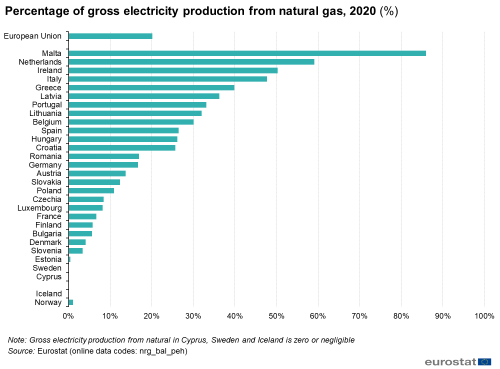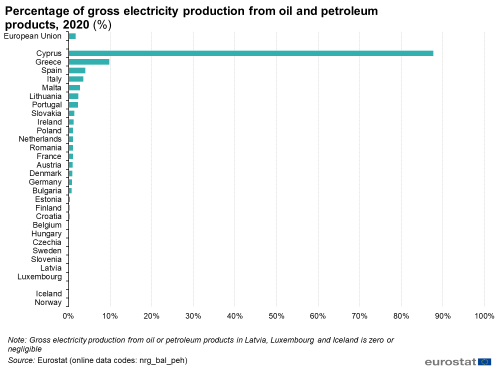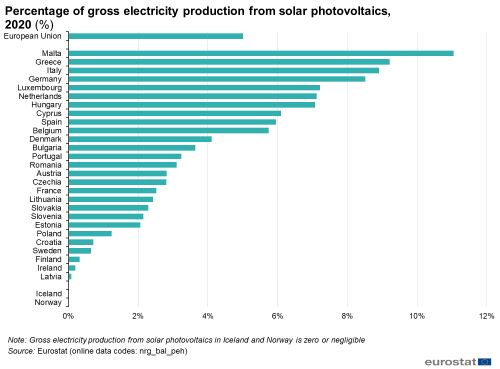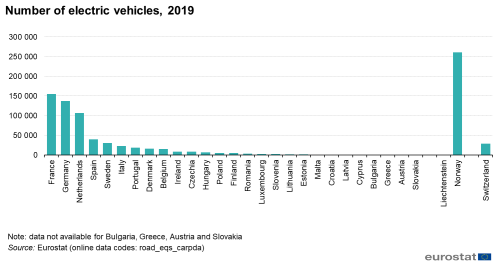Archive:Electric vehicles and energy generation statistics
Data extracted in February 2022.
Planned article update: XX XXXX 202X.
Highlights
This article sheds light to electricity generation and transport data of electric vehicles. It covers the European Union (EU) and when available, it also includes data from Iceland, Liechtenstein and Norway. The first part analyses electricity generation data. Electricity generation per country is a strong indicator of the energy source used for the electricity consumed for charging electric vehicles. However, electricity trade can affect this picture. The second part of the article describes electric vehicles' total consumption trends at county level.
Full article
Electricity sector data analysis
Gross electricity production
At EU level in 2020 (figure 1), Renewables and biofuels offered 39.1 % of the total gross electricity production, nuclear contributed by 24.6 %, natural gas and solid fossil fuels production corresponded to 20.1 % and 12.6 % respectively.
Figure 2 shows the percentage of gross electricity production from solid fossil fuels. Poland, Czechia and Bulgaria, with 68.0 %, 38.1 % and 33.2 % respectively, are the countries with the highest percentage of gross electricity production from fossil fuels. Gross electricity production from solid fossil fuels in Sweden, Estonia, Cyprus, Latvia, Lithuania, Luxembourg, Malta, Iceland and Norway is zero or negligible.

(%)
Source: Eurostat (nrg_bal_peh)
Figure 3 depicts the percentage of gross electricity production from natural gas. In the EU, the share of gross electricity production from natural gas is 20.1 %. Malta with 85.9 %, Netherlands (59.1 %) and Ireland (50.3 %) produce more than half of their gross electricity from natural gas. Gross electricity production from natural gas in Cyprus, Sweden and Iceland is zero or negligible.

(%)
Source: Eurostat (nrg_bal_peh)
Figure 4 shows the percentage of gross electricity production from oil and petroleum products. Except from Cyprus, with 87.7 %, Greece with 9.8 % and Spain with 4.1 %, EU countries have low or negligible percentage of gross electricity production using oil and petroleum products. Oil and petroleum products are used for the electricity production in small islands isolated electricity systems. However the increasing penetration of renewables reduces their contribution.

(%)
Source: Eurostat (nrg_bal_peh)
Figure 5 presents the share of nuclear in the gross electricity production. The countries that use nuclear energy in their mix are France, Slovakia, Hungary, Belgium, Bulgaria, Sweden, Slovenia, Czechia, Finland, Spain, Romania, Germany and Netherlands. The highest percentage was in France that produced in 2020, 66.9 % of its net electricity using nuclear when the lowest from the producing countries is in the Netherlands with 3.3 %.

(%)
Source: Eurostat (nrg_bal_peh)
Regarding the percentage of wind production in 2020, Denmark, Ireland and Lithuania have the highest with 56.8 %, 35.8 % and 29.2 % respectively. Gross electricity production from wind in Slovenia, Slovakia, Malta and Iceland is zero or negligible.

(EUR per kWh)
Source: Eurostat (nrg_bal_peh)
Figure 7 shows the percentage of solar in gross electricity production in 2020. Malta, Greece and Italy have the highest percentage with 11.1 %, 9.2 %, 8.9 % respectively. The lowest is observed in Finland (0.3 %), Ireland (0.2 %) and Latvia (0.1 %). Gross electricity production from solar photovoltaics in Iceland and Norway is zero or negligible.

(EUR per kWh)
Source: Eurostat (nrg_bal_peh)
Electricity consumption for road transport
In the electricity consumption in the road sector, electric vehicles charging is included as well as the energy consumption of electric trolley busses. In absolute terms for 2020, we see the positive example of Norway, where 1 089 GWh are mostly used for charging electric vehicles. Other positive examples are the Netherlands and Sweden with the consumption of 673 GWh and 495 GWh respectively, mostly for electric vehicles charging. At this stage, electricity consumption in the road sector stays statistically under-reported. Therefore, the data are not yet stable, and their quality is lower than expected.
Transport sector data analysis
Development of electricity prices for non-household consumers
Figure 9 shows the change in electricity prices for non-household consumers including all non-recoverable taxes and levies from the first half of 2020 to the first half of 2021. For comparison purposes the national currencies were used. These prices dropped in eleven EU Member States. The biggest decreases were recorded in Slovenia (-6.5 %) and Portugal (-5.2 %), closely followed by Romania (-5.1 %). It increased in the other sixteen EU Member States. We recorded by far the largest increase in Denmark (29.8 %), with Bulgaria in the second place (18.0 %), followed by Estonia (16.3 %). Other countries with an increase of 10.0 % or more are Ireland (14.0 %), Lithuania (10.9 %) and Greece (10.0 %).

(%)
Source: Eurostat (nrg_pc_205)
Share of transmission & distribution costs for non-household electricity consumers
Figure 10 presents the share of transmission & distribution costs for non-household electricity consumers. Transmission and distribution costs are only reported once a year, at the end of the second semester. Therefore this section refers to 2020 data. As for households consumers, distribution costs account for the largest share, compared to transmission costs. This is normal for all types of networks including the electricity system. Transmission network is used for transmitting bulk amounts of energy in long distances. The distribution network is usually where the consumers are connected. The distribution network is denser than the transmission network, therefore, its share at the costs are expected to be higher.
Countries with lower population density more extensive transmission network to meet their needs. Its costs are higher, when compared to the countries with higher population density. Smaller, densely populated countries use mostly their distribution network.
However, several non-households consumers can be directly connected to the transmission network or use part of the distribution network (medium voltage only). Therefore, transmission cost share can be higher when compared to households consumers.
In 2020, Luxembourg, Czechia and Sweden have the highest share of distribution costs, with 91%, 90.8% (estimated) and 87.8% respectively. In 2020, Belgium, Italy and Denmark have the highest share of transmission costs with 57.6 %, 54.2 % and 48.0 % respectively.
|alt=100% vertical stacked bar chart on the share of transmission and distribution costs paid by non-household consumers for electricity in 2020 in the EU Member States and some EFTA countries, candidate countries, potential candidates and other countries. Each bar shows the share of transmission costs and the share of distribution costs.Source data for tables and graphs
Data sources
Energy commodities extracted or captured directly from natural resources are called primary energy sources, while energy commodities which are produced from primary energy sources in transformation plants are called derived products. Primary energy production covers the national production of primary energy sources and takes place when natural resources are exploited, for example, in coal mines, crude oil fields, hydropower plants, or in the fabrication of biofuels. Whenever consumption exceeds primary production, the shortfall needs to be accounted for by imports of primary or derived products.
The heat produced in a reactor as a result of nuclear fission is regarded as primary production of nuclear heat, alternatively referred to as nuclear energy. It is calculated either on the basis of the actual heat produced or on the basis of reported gross electricity generation and the thermal efficiency of the nuclear plant. Primary production of coal and lignite consists of quantities of fuels extracted or produced, calculated after any operation for the removal of inert matter.
Context
In 2016, the European Commission presented the European Strategy for Low-Emission Mobility COM2016(501) final. The Commission identified low-emission mobility as an essential component of the broader shift to the low-carbon, circular economy needed Europe to stay competitive and be able to cater to the people and goods mobility needs.
The Fit for 55 legislative proposals cover a wide range of policy areas including climate, energy, transport and taxation, setting out the ways in which the Commission will reach its updated 2030 target in real terms.
Direct access to
Other articles
Main tables
- Energy (t_nrg), see
- Energy statistics - main indicators (t_nrg_indic)
- Electricity prices by type of user (ten00117)
Database
- Energy (nrg), see:
- Energy statistics - prices of natural gas and electricity (nrg_price)
- Energy statistics - natural gas and electricity prices (from 2007 onwards) (nrg_pc)
- Energy statistics - natural gas and electricity prices (until 2007) (nrg_pc_h)
Dedicated section
Methodology
- Energy statistics — electricity prices for domestic and industrial consumers, price components (ESMS metadata file — nrg_pc_204_esms)
Visualisations
External links
- Eurelectric
- Europe's Energy Portal
- European Commission — Energy
- Weekly oil bulletin (weekly pump prices)
- State of the energy union reports (State of the energy union reports)


